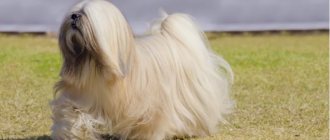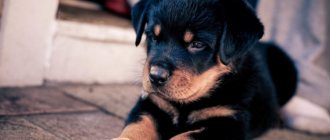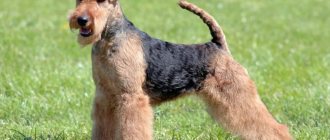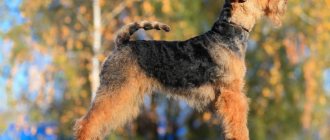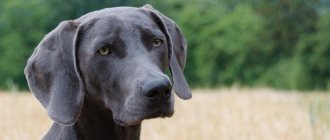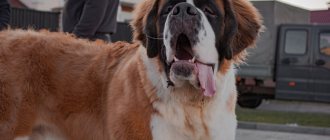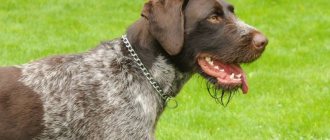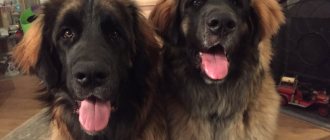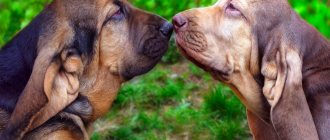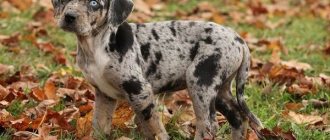The Lhasa Apso is a dog breed that has its origins approximately 2,000 years ago in the mountains of Tibet. Actually, the name of the breed also has a rather characteristic translation - “mountain goat”. This unusual name was given to the breed because of its rather long coat and ability to gracefully overcome mountain slopes.
The Lhasa Apso is a dog breed that has its origins approximately 2,000 years ago in the mountains of Tibet.
Lhasa Apso puppies have been revered by the inhabitants of Tibet at all times and have been a talisman that brings good luck and happiness to the owner. It was considered a sign of special respect to give a person a Lhasa terrier puppy. It is not surprising that they were often given as gifts to wealthy officials and even emperors. Among the monks of Tibet, dogs were revered as sacred creatures, so their export outside their homeland was prohibited. Largely thanks to this fact, it has been possible to preserve the “pure blood” of the breed to this day.
Description of the Lhasa Apso breed
Popularity 63rd place among 263 dog breeds
Lifespan:
12-14 years old
Breed group:
Decorative
Height:
20-26 cm
Country of origin:
China
Average price:
40-50 thousand rubles
Weight:
6-7 kg
Latest articles Cat health
Ataxia in cats: what it is, how it manifests itself and is treated 01/23/2022 151 0 0
Cat health
Leukemia, or viral leukemia in cats 01/23/2022 140 0 0
Breed traits
Breed traits (on a 5-point scale)
| Lhasa apso | |||
| Activity | in the house | 3.1 | |
| on the street | 3.1 | ||
| Obedience | training | 2.7 | |
| strangers | 3.2 | ||
| Domination | in family | 3.5 | |
| over dogs | 3.7 | ||
| Defending your territory | from people | 4.1 | |
| from dogs | 4.2 | ||
| Sociability | in family | 4.1 | |
| with strangers | 2.3 | ||
| with dogs | 2.7 | ||
| Concentration | in family | 2.4 | |
| in front of strangers | 3.1 | ||
| with dogs | 2.8 | ||
| Aggressiveness | in family | 3.2 | |
| to strangers | 3.6 | ||
| to the dogs | 3.4 | ||
| to cats | 2.9 | ||
| Family behavior | calmness | 3 | |
| demand for affection | 3.6 | ||
| excitability | 4.5 | ||
| playfulness | 3.5 | ||
| excessive barking | 3.4 | ||
| behavioral breakdowns | 2.2 | ||
| Tolerance for children | up to 4 years | 2.2 | |
| over 4 years old | 2.8 | ||
| Institutional use | watchman | 4.4 | |
| bodyguard | 2.8 | ||
This breed is often compared to the following dog breeds: Shih Tzu, Tibetan Terrier, Bichon Frize, Japanese Chin, Pembroke Welsh Corgi.
The photo shows what a Lhasa Apso looks like:
Key facts
These little mascots became the ancestors for many modern breeds. In ancient times, their main habitats were Buddhist monasteries. They were very revered, since the dogs, by barking, helped to find out about the enemy’s approach. The description of the Lhasa Apso breed necessarily includes a large historical block.
Dogs are very smart, quick-witted, and often like to command. If something doesn’t go according to their will, the four-legged beauties will be very stubborn. They need good education. Wool is their calling card. They shed little, but to maintain the well-groomed appearance, quality, and beauty of the fur, it is necessary to properly care for it.
The ancestors of the Lhasa beauties are considered to be mountain wolves and ancient dogs. Beliefs say that they bring real happiness; their name, according to one translation interpretation, means “statue of peace and prosperity.” The name can also be translated as “goat-like” or “dogs from Lhasa with a beard.”
There is an even more interesting meaning - “dinner admirers”. According to the oldest legends, hungry monks went out into the world with their teachings, wanting to get some food. They trained the dogs to sigh deeply and loudly to evoke compassion from passers-by. The people took pity on the small animals and generously treated the monks with food; they were also given more alms.
The characteristics of the Lhasa Apso breed necessarily affect care and maintenance. If the dog is fed correctly, follows the vaccination schedule, and is given adequate exercise, then it will live a long and happy life. By the way, the life expectancy of the Lhasa Apso is very long: lap dogs can easily live up to 14-15 years.
Theses
- These are smart but headstrong dogs who want to please themselves, but not you.
- Leaders who will boss you around if you let them.
- They have a talent for guard duty that has been developed over centuries. Socialization and training are necessary if you want to have a friendly dog.
- They grow and mature slowly.
- They have beautiful wool, but it requires a lot of care for a long time. Be prepared to either spend time or money on the services of a professional.
History of the origin of the Lhasa Apso
There is no exact information about who brought the breed to other countries from Tibet. The first mention of it is in the notes of Sir Lionel Jacobs, made in 1901. Three years later, a description of the dogs was published in a well-known UK magazine. This detailed characteristic became the basis for the exterior standard, which has not yet been changed.
The prehistory of the central region of Asia has been little studied. However, it is known for sure that hunters and shepherds roamed these vast territories. At the end of the 8th century, monasteries began to be built. At the beginning of the 19th century, Tibet was invaded by English colonists who brought the so-called Lhasa terriers, which previously bore the name Bhuter terriers, into the territory of the Tibetans. In fact, they can be considered the ancestors of the Apso.
Then, in the 1920s, other British expeditioners, led by Colonel Bailey, took two males and one female abroad as a gift from the Dalai Lama. The colonel began breeding individuals in Great Britain itself.
In the mid-30s of the 19th century, he clarified the exterior parameters and gave the official name to the breed in honor of the capital of Tibet in order to capture the true origin of the animals in their name.
Sir Bailey's American friend, Sir Sidham Cating, also received a gift from the Dalai Lama - two wonderful males and a female. This marked the beginning of the spread of dogs in America. After which the American line of the breed appeared with the prefix Hamilton. However, since the beginning of the century, many began to independently export dogs from their homeland as pets. They were so beautiful and unusual that Europeans could not resist purchasing such a charming creature with amazing shiny fur. In 1965, the breed became fully official thanks to descriptions of the Kennel Club, and in 1970 it received one specific name - Lhasa Apso (the Tibetan Terrier was classified as a separate type).
They appeared in Russia in the mid-30s of the 19th century. Even in the 70s, the number of individuals was very small. By the 90s, representatives of the breed stopped appearing at competitions altogether. But in 1993, the head of the Chinese House club, Margarita Lenkova, managed to get two litters from Europe, including two males and four females. Since that time, their shelter began to breed decorative Asian dogs.
Since 1994, Lhasa Apso began to be exhibited at all-Russian exhibitions. A year later, a bitch named Badrian Mani Padme, whose owner was Margarita Lenkova herself, became the owner of the title “Champion of Russia”.
Price
This is a rather rare breed in our area, the cost of which for this reason is rather high. In the capital's nurseries you can find purebred long-haired beauties. The price of a Lhasa Apso is from 35 thousand rubles.
In other cities of Russia you can also buy such a dog, its cost will be lower. For example, in Yekaterinburg there is also a nursery for this breed. There they sell puppies for 20 to 30 thousand rubles.
If you are a metropolitan resident who wants to save money on purchasing a purebred Lhasa Apso, you can arrange for its transportation from another city, paying for delivery and other expenses. This way you will save at least 5 thousand rubles.
Appearance of Lhasa Apso
General impression
These miniature mascots are incredibly cute, elegant, and graceful. Nature rewarded them with a peculiar appearance. Breeders had virtually no involvement here. These are unique pets with a special charm. The balance between the parameters of body parts, sparkling eyes, a mouth that looks like a wide smile are their main features, noticeable in any photo of a Lhasa Apso.
Head
Small spherical skull. Correct proportions between the frontal lobe and the muzzle. The back of the head is in the form of a small tubercle, the frontal lobe is generally rounded, with a small ditch in the middle. The head is slightly shortened, with a wide muzzle. The jaw is very strong, with beautiful white teeth, a rectangular mouth with a bright pink, even crimson, small tongue.
The eyes are small, black, the whites are not visible. In general, the features of the muzzle are graceful and even.
Neck
The strong neck has a characteristic curve, hidden under a dense layer of fur. The neck is of medium length, quite muscular, very mobile.
Torso
The body is rectangular in shape, significantly longer than the limbs. The lower back is straight. The Apso has a very strong and robust back, as well as a thoracic spine. The ribs protrude slightly, the rounded chest is clearly pushed forward. The pelvis is narrower than shoulder width. The tummy is well tucked. The croup has a round shape.
Forelegs
The musculoskeletal system is powerful, with flexible joints and strong muscles. Compared to the length of the body, the legs are quite short. They look like cat paws, as the toe pads are clearly defined. The pasterns are round in shape.
Hind limbs
Hock joints have a parallel structure. The muscle frame is clearly defined. The hind limbs are almost perfectly equal to the forelimbs. In the standard position, the hind legs have a smooth oval curve.
Tail
The tail is high set with a slight unusual bend at the tip. During movement, the tail is thrown over the back. It is completely protected by a thick wool layer.
Movements
The pet's movements are confident, with a quick response to commands or external stimuli. While running, the paws are freely and easily thrown forward, making smooth swings. Quadrupeds move confidently, run very quickly, and move deftly while playing or hunting.
Wool
The hair has a dense, heavy structure. It is not silky or smooth as it may seem. The wool completely envelops the body in a thick robe. The undercoat is of medium density. In particular, there is a lot of fur on the paws, belly, ears, and on the face, due to such density, a mustache and beard are formed. There is also slight fraying between the toes. An even parting is usually formed on the forehead.
Color
Lhasa dogs have a wide range of fur shades. Often there are such interesting colors of the Lhasa Apso as tortoiseshell, sable, honey, two-tone or even with three different tones.
Size
The height of Lhasa Aspo in males is on average 25.4-26.2 cm with an average weight of 5.4-7 kg. Females, as a rule, are smaller than males and have softer facial features and body parameters. The Lhasa Apso's weight of 7-8.2 kg corresponds to a height of 26.3-27.3 cm, this is considered the maximum size.
Health
Characteristic diseases
Apso has few health problems. Usually good care avoids the need to resort to veterinarians.
However, sometimes the following diseases occur:
- hip dysplasia;
- inflammation of the eyes and ears;
- kidney problems of varying severity;
- severe allergic reactions to parasites.
Moving or any transportation is not very stressful for these cute dogs. They easily adapt to changing circumstances
Vaccinations
The first vaccination is given at one and a half to two months; revaccination, or the second vaccination, is carried out a couple of weeks after the first.
After changing baby teeth, a third vaccination is given against certain diseases and against rabies.
Then, routine vaccination is carried out once a year. Before each vaccination it is necessary to carry out deworming.
A sensitive watchman, an insightful friend and a hardy companion, the Lhasa Apso is almost the ideal embodiment of man's best friend. And if you are ready to emotionally invest in his upbringing, you will end up with a gentle creature who is devoted only to you with all his heart
Personality of the Lhasa Apso
The character of the Lhasa Apso can be called wayward, sometimes even selfish. They need an owner with a strong backbone and a lot of patience. Since in their distant past they served as real guards, warning the monks of approaching danger, their temperament retained the traits of true watchmen. Dogs are very brave, despite their not intimidating size.
They constantly want to be in the center of all events, to receive all the attention of large companies or their owner. These dogs are extremely loyal. Loneliness is their main fear.
These companions are friendly, cheerful, love to be mischievous and move a lot, play, entertaining those around them. They get along well with small children, but often try to avoid their company, as they like to decide for themselves who can touch them and when. Also, apsos do not tolerate rude treatment and negligence.
These furry friends are very smart: they are able to quickly pick up new commands and complete quick-witted tasks. They have excellent hearing and sense of smell. In Ancient Tibet, these features greatly helped dogs, and today Lhasa Apso instantly find things lost in the house.
They are good with other domestic animals. But if Lhasa creatures begin to be limited in attention, jealousy manifests itself in their attitude towards other pets, including disobedient behavior and unusual reactions to commands.
Attitude towards children and pets
Lhasa Apsos do not tolerate rudeness or excessive attention from children. It is recommended to purchase them for families with older children. Always supervise any interactions between dogs and small children. Teach your child never to approach any dog while it is sleeping or eating, or to try to take food from it. No dog should be left unattended with a child.
The Lhasa Apso can get along with other pets if properly introduced.
Education and training
Excellent students in training - this is about Lhasa Apso. With these dogs, even avid lovers of lazy home gatherings will love movement and an active lifestyle. Fluffies are always full of energy, the desire to move, play and charge everyone around with positivity. From birth, dogs need communication and great attention.
The process of raising and training the Lhasa Apso is best done in the form of a game. In this way, new commands are learned properly. It is important to praise your pet in a timely manner. But mischief or disobedience must be suppressed with a threatening tone or appropriate punishment, since your little pupil must see you as an authority and obey.
Constant development and training in new commands are exactly what representatives of this breed need. It is important to follow a certain training plan, without loading the “student” with new lessons at a time, but also without taking long breaks between the learned material. Order is important here. It is not recommended to show aggression, because apsos remember a bad or dismissive attitude for a long time.
At a young age, it is necessary to show the pet who is its owner. Without shouting, sudden movements, or anger, negative behavior or failure to comply with certain commands should be indicated. Already a six-month-old friend should definitely know the basic commands: “Place!”, “Come to me!”, “Ugh!” Study your companion's behavior from the outside, observe him. This will help you understand which details in training need to be given more attention.
Video
If you are determined to become the owner of a Lhasa Apso dog, get ready for some difficulties that appear in life with these cute creatures. These dogs require a lot of attention, love, care, they love walks, so they take a lot of time and this load is often difficult for young, inexperienced dog breeders to cope with. But having gained the trust of your pet, you can count on his boundless devotion, which is something some other dogs lack. What to choose: complexity and devoted friendship or minimal care and weak affection? We are also wondering if you have ever had problems with your dog shedding or allergies at home? Share your feedback in the comments.
Health and disease of the Lhasa Apso
Possible diseases
With proper care, dogs rarely get sick. Their immunity is strong. Miniature Lhasa dogs are characterized by:
- kidney diseases of varying severity;
- problems with the functioning of joints, especially the hip;
- inflammatory processes in the ears, eyes;
- allergies from the presence of parasites in the body.
Most often, representatives of the breed suffer from a genetic disease associated with eye inflammation. The eyes require periodic examination. Peeling or other allergic reactions may often appear on the skin due to thick fur. It is important to detect skin lesions in time and contact a veterinarian.
Reproductive health
Before you start breeding puppies, it is recommended to contact a club that sells individuals of this breed. This is necessary so that in the future there will be demand for your broods, that is, there will be buyers.
On average, females are in heat for 21 days, with a break between cycles of 6-10 months. But there may be individual deviations, since all dogs are different. The most suitable age for mating is 2.5-5 years. Before mating, it is important to undergo an examination, take smears for tests, expel worms if they are present in the body, and adjust the bitch’s diet.
It is best to do this 1-2 months before the start of estrus. From 7-8 days you need to check the color and consistency of the discharge using a cotton swab. When the color becomes pale pink or completely transparent, you can start knitting.
It is recommended that a pregnant bitch be given vitamin complexes prescribed by a veterinarian. You should not severely limit her activity or change her diet. Only towards the middle of pregnancy should you increase the portion size, but not by much.
Diseases and their prevention
Lhasa Apso are aboriginal dogs, so representatives of this breed have excellent health and a balanced psyche. Animals are considered long-lived, and some specimens manage to overcome the twenty-year age limit, which is a rather rare occurrence for dogs.
Table: diseases of Lhasa Apso
| Disease | Description of the disease | Treatment |
| Patella dislocation | Dislocation occurs when intrauterine development is disrupted. A puppy may look completely healthy, but be prone to sprains. In advanced cases, the dog is unable to lean on the injured paw | The problem can be partially solved by reduction or surgery followed by treatment. The animal should be protected from excessive physical exertion, since an increased tendency to dislocation remains even after surgery. |
| Hip dysplasia | The disease is congenital, but the first symptoms appear after 15 months. Begins to manifest itself in the form of limited movement, pain, and can lead to absolute immobility | For dysplasia in dogs, treatment with medications includes prescribing medications to regenerate joints and reduce pain. During the treatment period, physical activity is not excluded for the dog, but it should be moderate |
| Atrophy and luxation of the lens | A hereditary disease manifests itself in disruption of the photoreceptors of the eye. The first symptom is decreased vision in the dark. Lens luxation is a complete or partial displacement of the lens from its normal point due to congenital underdevelopment or weakness of the zonules | Treatment depends on the potential preservation of vision in the damaged eye, the presence of glaucoma, and the location of the lens. Therapy is aimed at treating the underlying disease, reducing intraocular pressure, surgical removal of the lens in case of anterior dislocation |
| Heart murmurs | Abnormal sounds that occur as blood passes through an organ. May be part of many diseases | Noise as such cannot be treated. The cause of the noise may or may not be treatable - it depends on the type of pathology, the degree of its severity and other circumstances (age, condition of the animal, concomitant diseases, cost of treatment, etc.) |
| Cataract | An eye disease that develops mainly in older dogs and is accompanied by clouding of the lens of the eye | The intensity and need for therapy is determined by a specialist |
| Renal dysplasia | An extremely severe pathology associated with a violation of the functional division of organ cells. With this pathology, the kidneys lose their ability to filter blood and synthesize urine. | Complex drugs and painkillers are used for treatment. If treatment does not help, veterinary intervention will be required. To prevent kidney disease, you need to follow a low-protein diet and walk your pet for a long time every day. |
| Allergy | An abnormally increased reaction of the body to some foreign substance that has entered it by any means | The appropriate medicine can relieve itching and other symptoms for a short period of time, but for effective treatment it is necessary to correct feeding, and in case of atopic dermatitis, improve maintenance at home |
Features of feeding and diet
Professional dog breeders, trainers and veterinarians say that you should not feed your animals table food. The dog must eat food individually prepared for it. Veterinarians also recommend not mixing food with homemade food, as this can cause disruption of the digestive tract. The animal should always have access to clean drinking water at room temperature.
Pets are quite active, so their diet should be sufficiently high in calories, but not exceeding the norm. The following will be especially useful:
- cereals;
- vegetables;
- lean poultry meats;
- sea fish;
- beef, rabbit, steamed or boiled;
- some offal;
- porridge with water or with the addition of milk (half with water).
Milk should be given periodically, for example, kefir and cottage cheese without sweetening. Children are given warm whole milk once or twice a day - it will be beneficial, but it is not advisable to give it to an adult dog.
It is also not recommended to feed Lhasa Apso:
- raw meat and eggs;
- highly peppered or salted food;
- pork;
- bones;
- smoked products;
- various sweets, baked goods.
At the age of 3-5 months it is recommended to feed once a day. From 5 to 7 months – 4 times. From 7 to 8 months - 3 times a day, and from 8 months onwards - 2 times.
Advantages and disadvantages
If we talk about the advantages of the Lhasa Apso, the breed can boast of:
- a flexible mind that provides excellent learning ability;
- cheerful disposition;
- suitable character and size for keeping in an apartment;
- devotion to the owners.
But this is not without its drawbacks. To begin with, they do not get along very well with children. The dog, despite its small size, will not tolerate excessive freedom in relationships.
Such a pet is quite expensive due to the rarity of the breed. Finally, you will have to regularly go to a specialist for haircuts - the hair grows back surprisingly quickly.
Care and maintenance
Asian decorative apsos are the owners of luxurious thick fur, which is impossible not to pay attention to. The texture of the hair is similar to human hair - it shines and shimmers beautifully. But: dogs shed quite a lot, which causes a number of inconveniences for their owners. The pet must be combed frequently (about 2-3 times a day) with combs or mittens with spikes, which are sold in pet stores. Bathing is carried out using special shampoos, balms, and other products, and after water procedures the animal is thoroughly dried.
The basic rules for the care and maintenance of the Lhasa Apso are timely walking (on average 2-3 times a day), a properly formulated diet, hygiene, a lot of activity and attention. The dogs are pretty clean. Lhasa Apsos are big fans of digging in dense bushes and all kinds of vegetation. During a walk, you should carefully monitor your pet, and when you come home, you need to wipe its paws, remove thorns, leaves, sticks, or even small debris from its fur.
The dog should have his own place with a bed, dice or balls. These things will be needed to prevent furniture, shoes and other things from falling into the puppy's mouth.
The size of the Lhasa Apso suggests that it will be kept in an apartment or inside a private house, but an active pet will not mind running around on the lawn in front of the cottage or on the playground in the neighborhood.
Application
Since ancient times, the Lhasa Apso had the honorable duties of a guard due to its attentiveness, sensitive hearing and loud bark.
To this day in Tibet he diligently fulfills this role.
However, for the rest of the world, this dog is, above all, a wonderful companion, a sweet, playful friend, just like the German Spitz and Papillon .
The Lhasa Apso is an unpretentious dog. She does not need a special temperature regime or a particularly soft bed. She will feel comfortable at your feet on the rug
Tips for choosing a puppy
Due to their stubborn nature, Apso dogs are suitable for very patient owners. Wool requires proper attention and care, and health requires great responsibility. These furry companions are not very popular and widespread in our country, but there are enough nurseries that breed and sell them. Choose conscientious breeders, clarify breeding details, ask for certificates confirming breeding.
You can understand a lot by seeing the parents of Lhasa Apso puppies. The external parameters of both males and females must comply with recognized exterior standards. Babies begin to be given away at the age of 2.5-3 months. When choosing a puppy, evaluate the behavior of other animals, the mother, their condition, appearance and some reactions.
Character and temperament
Apso is a unique and contradictory dog. According to the breeders, despite its small size, it has the soul and heart of a large dog. They are cheerful and funny, independent friends, but at the same time they require increased attention, special patience, and they need strict discipline.
Pros:
- patience;
- friendliness towards owners and family members;
- vigilance and caution;
- playfulness and energy;
- self confidence;
- fearlessness;
- attachment to people.
But representatives of this breed also have disadvantages :
- Lhasa are wayward;
- the dog requires attention and a subtle understanding of its nature;
- don't like to be alone.
Main characteristics
| Breed parameters | |
| Country of origin: | Tibet |
| Weight of the breed: | males: 6-8 kg, females: 5-7 kg |
| Height at withers: | males: 25-28 cm, females: 25-28 cm |
| Temperament: | moderate |
| Wool: | long |
| Role in human life: | companion, watchdog |
The Lhasa Apso is an amazing dog that makes you fall in love at first sight. These animals are truly luxurious and endowed with an aristocratic appearance. They are playful, excellent as a companion, and, if necessary, are ready to show character and defend their owner.
How to choose the right puppy?
Choosing a real Lhasa puppy is not as easy as it might seem at first glance, since the breed is relatively rare. By buying online based on a photo, you can get something similar to a Tibetan treasure. You should also not look for such a pet in the markets. It is best to seek help from professional breeders.
Professional nurseries will be able to offer the future owner a purebred puppy, free from various diseases and genetic problems. After all, having received a mestizo, no one knows what you might encounter.
A purebred puppy must have a full package of documents; parents must have exhibition certificates confirming the breed and the absence of defects. Healthy babies are active, strong, with beautiful fur, well-fed and curious.
